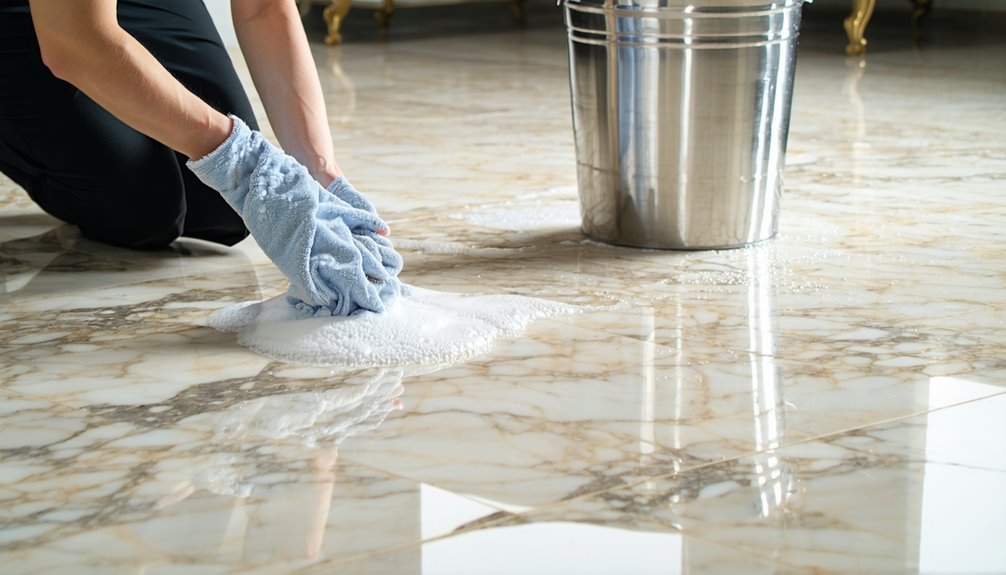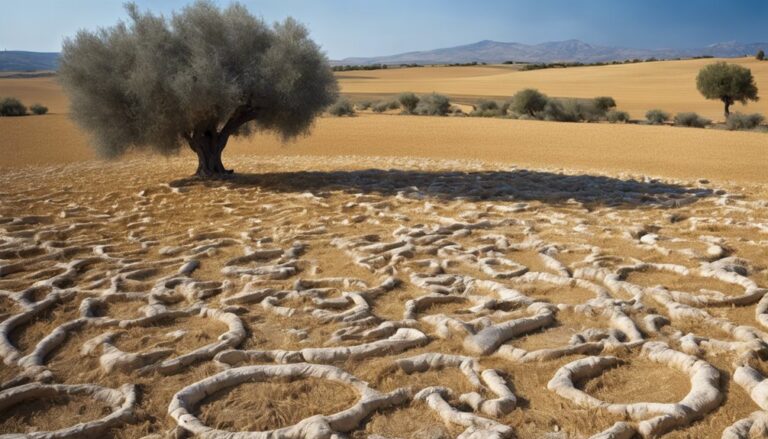To clean marble floors effectively, start by sweeping regularly to remove dirt and prevent scratches. Use a soft-bristled broom and a pH-neutral cleaner mixed with water for daily mopping. For tough stains, blot immediately with a soft cloth; a baking soda paste is great for oil stains, while rubbing alcohol works on ink. Deep cleaning involves sweeping, mopping with a pH-balanced solution, and scrubbing stubborn grime. Always rinse and dry the floor thoroughly. Don't forget to seal honed finishes annually to protect against stains. There's more to learn about maintaining your marble's beauty and integrity.
Understanding Marble Floor Care
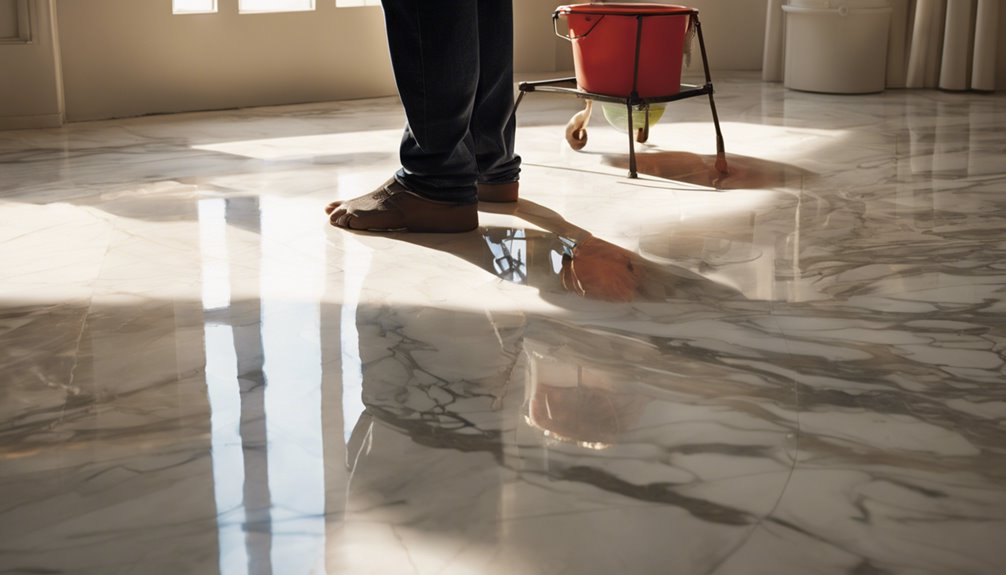
When you consider caring for marble floors, it's essential to understand their unique characteristics and needs. Different marble types, such as Carrara, Calacatta, and Crema Marfil, each possess distinct qualities that can affect their maintenance. The floor finishes—polished, honed, or tumbled—also play a significant role in how you should care for them. Polished finishes, while beautiful, can be more prone to scratches and etching, requiring careful cleaning solutions. Honed finishes, on the other hand, are less slippery but can be more absorbent, necessitating regular sealing. Understanding these factors allows you to create a tailored care routine, keeping your marble floors both stunning and durable. Embracing this knowledge gives you the freedom to maintain your space with confidence.
Essential Cleaning Supplies
To effectively clean your marble floors, you'll need the right supplies. This includes both recommended cleaning products and essential tools that guarantee a thorough clean without damaging the surface. Additionally, considering natural cleaning solutions can provide a safe alternative that maintains the beauty of your marble.
Recommended Cleaning Products
Choosing the right cleaning products for marble floors is essential to maintaining their beauty and longevity. To guarantee your marble stays pristine, consider these recommended products:
- pH-neutral cleaner: It's gentle and effective for regular cleaning, preventing damage from harsh chemicals.
- Marble polish: Use this every few months to restore shine and protect your floor's surface, enhancing its elegance.
- Sealer: Apply a high-quality sealer annually to protect against stains and spills, extending the life of your marble.
Tools for Effective Cleaning
Having the right tools is vital for effectively cleaning marble floors and ensuring they remain in top condition. Start with high-quality mop types, like microfiber or sponge mops, which are gentle on marble while effectively lifting dirt. Avoid using abrasive mops or scrub brushes, as they can scratch the surface. You'll also need a bucket for mixing cleaning solutions and a soft cloth for drying and polishing. Invest in a vacuum cleaner with a soft brush attachment to remove dust and debris without damaging the finish. Finally, consider a pH-balanced cleaner specifically designed for marble; it's essential to use the right cleaning equipment to maintain your floor's beauty and longevity. With these tools, you'll keep your marble floors looking pristine.
Natural Cleaning Solutions
After gathering the right tools for cleaning, the next step is to contemplate natural cleaning solutions that are safe for your marble floors. You want to avoid harsh chemicals, opting instead for eco-friendly solutions that preserve the beauty of your marble. Here are three effective vinegar alternatives:
- Baking Soda Paste: Mix baking soda with water to create a gentle paste. Apply it to stains and let it sit before wiping it away.
- Castile Soap: This plant-based soap effectively cleans without damaging the surface. Dilute it in water for a safe cleaning solution.
- Lemon Juice and Water: This mixture not only cleans but also leaves a fresh scent. Just make sure to rinse thoroughly.
These solutions keep your marble floors looking pristine while being kind to the environment.
Daily Cleaning Techniques
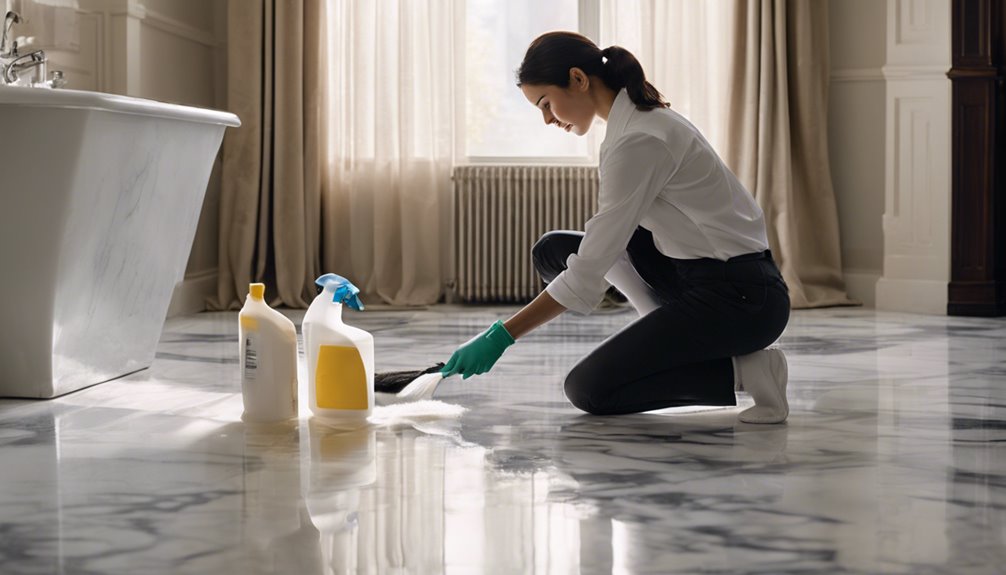
To keep your marble floors looking pristine, it's important to sweep them regularly to remove dirt and debris. Using a pH-neutral cleaner is also vital, as it helps maintain the marble's shine without causing damage. By incorporating these daily practices, you'll protect your investment and enhance the beauty of your floors.
Sweep Regularly
Regularly sweeping your marble floors is essential for maintaining their beauty and longevity. By incorporating effective cleaning schedules, you'll keep dirt and debris from scratching the surface. Here are three sweeping techniques to take into account:
- Use a Soft-Bristled Broom: This minimizes the risk of scratches while effectively removing dust.
- Sweep in One Direction: This method prevents debris from getting pushed around and guarantees a thorough clean.
- Schedule Regular Sweeps: Aim for daily sweeping, especially in high-traffic areas, to keep your floors looking pristine.
Use Ph-Neutral Cleaner
Maintaining the cleanliness of your marble floors goes beyond just sweeping; using a pH-neutral cleaner helps preserve their shine and prevents damage. Understanding the pH scale importance is vital here—cleaners with extreme pH levels can etch or dull your beautiful marble. When selecting a cleaner, make certain it's specifically labeled as pH-neutral, usually falling between 6 and 8 on the scale. This guarantees it won't react harshly with your marble. Mix the cleaner with warm water according to the manufacturer's instructions, and use a soft mop to gently clean your floors. Avoid abrasive tools or harsh chemicals, as they can harm the surface. By regularly using a pH-neutral cleaner, you'll maintain the elegance of your marble while promoting its longevity.
Dealing With Tough Stains
Although marble floors exude elegance, they can be susceptible to tough stains that require careful attention. To guarantee effective stain removal, follow these preventative strategies:
- Act Quickly: The sooner you address a stain, the better your chances of removal. Blot, don't rub, to avoid spreading the stain.
- Use the Right Solutions: For oil-based stains, try a mixture of baking soda and water. For ink or dye, a gentle solvent like rubbing alcohol can work wonders.
- Test Before Applying: Always test any cleaning solution on a small, inconspicuous area first to avoid damaging your marble.
Deep Cleaning Methods
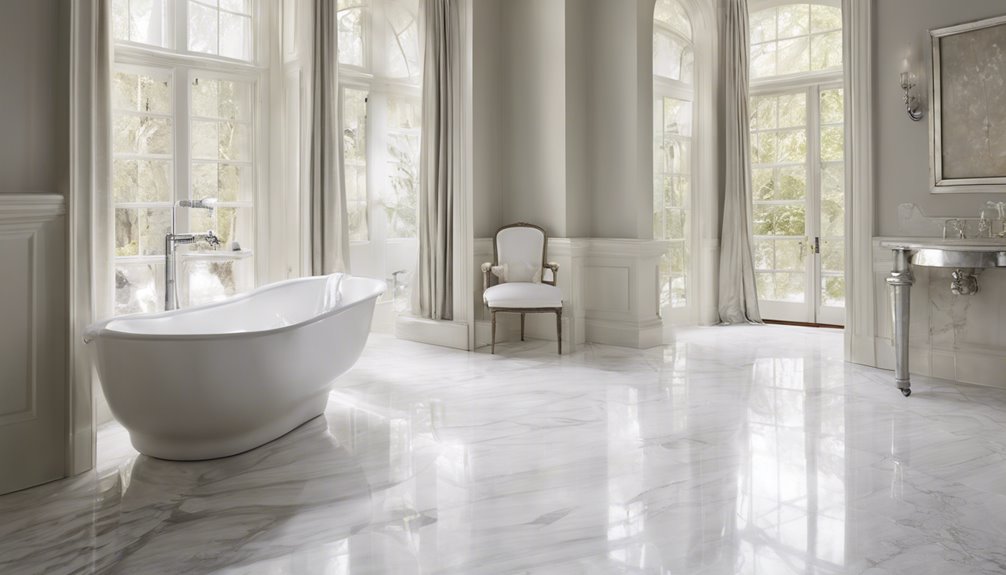
Deep cleaning your marble floors is essential for preserving their beauty and longevity. To start, gather your supplies: a pH-balanced cleaner, a soft-bristle brush, and a mop. First, sweep or vacuum to remove loose dirt. Then, apply the cleaner according to the manufacturer's instructions. For tougher grime, use deep cleaning techniques like intensive scrubbing with your brush, ensuring you're gentle to avoid scratching the surface. Rinse the area thoroughly with clean water to remove any residue. Afterward, dry the floor with a soft cloth to prevent water spots. Regular deep cleaning can keep your marble looking pristine, allowing you to enjoy its elegance without the worry of dullness or damage.
Preventative Maintenance Tips
To guarantee your marble floors remain stunning for years to come, regular preventative maintenance is key. By taking a few simple steps, you can assure surface protection and reduce the risk of damage. Here are three effective preventative measures you should adopt:
- Use mats and rugs: Place these in high-traffic areas to prevent scratches and dirt from accumulating.
- Seal your marble: Regularly applying a high-quality stone sealant will protect against stains and moisture penetration.
- Avoid harsh chemicals: Stick to pH-neutral cleaners specifically designed for marble to maintain its luster and integrity.
Incorporating these tips into your routine will help you enjoy your beautiful marble floors without worry, allowing you the freedom to appreciate their elegance.
Frequently Asked Questions
Can I Use Vinegar to Clean Marble Floors?
You shouldn't use vinegar to clean marble floors. Vinegar's acidity can damage the marble, causing etching and dullness over time. Instead, opt for pH-neutral cleaners specifically designed for stone surfaces. These will effectively clean without harming your beautiful floors. Always test any new cleaner in a small, inconspicuous area first. By taking these precautions, you'll maintain your marble's elegance and guarantee it lasts for years to come.
How Often Should I Polish My Marble Floors?
You should polish your marble floors every 6 to 12 months, depending on foot traffic and wear. For ideal marble maintenance, regular assessments help determine if they need polishing more frequently. If you notice dullness or scratches, it's time to act. Always use a suitable polishing product to enhance shine without damage. Staying on top of polishing frequency not only keeps your floors looking great but also extends their life, giving you peace of mind.
Are There Specific Cleaners to Avoid on Marble?
When it comes to marble maintenance, you'll want to steer clear of certain cleaning products that could wreak havoc on your beautiful floors. Avoid acidic cleaners like vinegar or lemon juice, as they can etch the surface. Likewise, stay away from abrasive scrubs that can scratch your marble. Instead, opt for pH-neutral cleaners specially designed for stone surfaces. Keeping your floors pristine means knowing what to dodge in your cleaning routine!
Is It Safe for Pets to Walk on Marble Floors?
Yes, it's generally safe for pets to walk on marble floors. However, you should consider pet safety by ensuring the surface isn't slippery, especially when wet. Regular marble maintenance helps keep the floors in good condition, reducing the risk of slips. Additionally, avoid using harsh chemicals that could harm your pets or damage the marble. With proper care, your furry friends can enjoy the beauty of your marble floors without any worries.
What Are the Best Mats to Protect Marble Floors?
You might not realize how much a great mat can protect your marble floors. When choosing marble floor mats, consider options with non-slip backing to prevent accidents. Look for protective rug options made from durable materials that can withstand wear and tear while offering style. Natural fibers like jute or synthetic blends can be ideal. Remember, a well-chosen mat not only preserves your floor but also enhances the aesthetic of your space.

